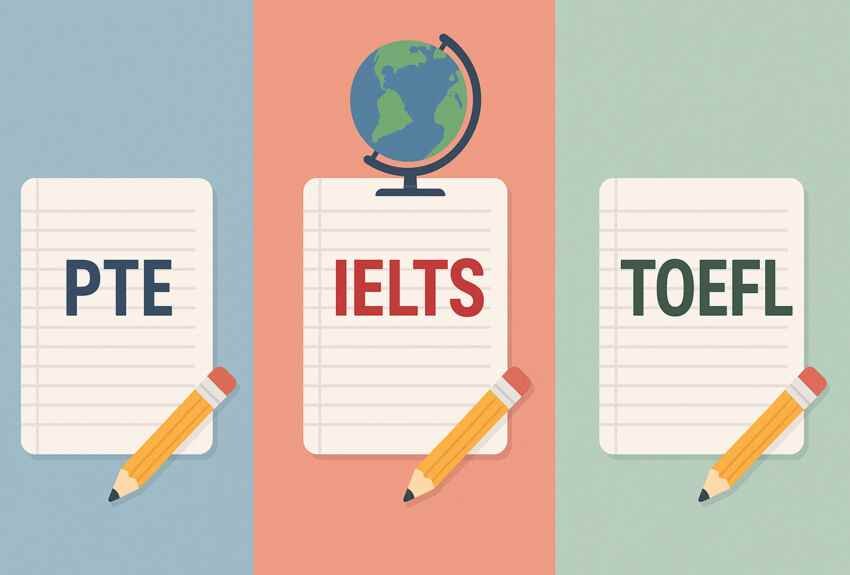
As an international student, proving your English language proficiency is essential for studying abroad. Choosing the right exam—PTE (Pearson Test of English), IELTS (International English Language Testing System), or TOEFL (Test of English as a Foreign Language)—can feel overwhelming. Each test comes with its own format, costs, and requirements, and the best choice depends on your goals, strengths, and target universities.
This blog breaks down these tests in detail to help you decide which one suits you best.
Understanding the Basics of PTE, IELTS, and TOEFL
Before diving into comparisons, here’s a quick overview of each test:
PTE (Pearson Test of English)
- Purpose: Tests English language skills for academic and immigration purposes.
- Format: Computer-based with sections integrated for speaking, writing, reading, and listening.
- Duration: 2 hours.
- Results: Available in 1-2 days.
- Recognition: Accepted by thousands of institutions worldwide, including Australia, Canada, and the UK.
IELTS (International English Language Testing System)
- Purpose: Measures English proficiency for education, migration, and work.
- Format: Two options—Academic (for study) and General Training (for migration/work); includes reading, writing, listening, and speaking tests.
- Duration: 2 hours 45 minutes.
- Results: Available in 5-7 days (paper-based) or 3-5 days (computer-based).
- Recognition: Accepted by over 11,000 organizations globally.
TOEFL (Test of English as a Foreign Language)
- Purpose: Assesses academic English skills.
- Format: Internet-based test (TOEFL iBT) covering reading, listening, speaking, and writing.
- Duration: 3 hours.
- Results: Available in 6 days.
- Recognition: Preferred by universities in the US and Canada.
Comparison Table: PTE vs IELTS vs TOEFL
| Criteria | PTE | IELTS | TOEFL |
| Test Type | Fully computer-based | Paper/computer-based (speaking in person) | Internet-based |
| Duration | 2 hours | 2 hours 45 minutes | 3 hours |
| Cost | ~$200 USD | ~$200–250 USD | ~$190–250 USD |
| Results Time | 1–2 days | 3–7 days | 6 days |
| Test Format | Integrated (skills combined) | Individual sections | Individual sections |
| Universities Accepted | 3,000+ institutions globally | 11,000+ institutions globally | 11,500+ institutions globally |
| Speaking Section | Recorded responses | In-person with an examiner | Recorded responses |
Key Factors to Consider
1. Cost and Accessibility
- If affordability is important, TOEFL or PTE may be better choices as their costs are often slightly lower.
- PTE provides quick results, making it ideal for last-minute test takers.
2. Test Format
- Prefer to avoid speaking with an examiner? Opt for PTE or TOEFL, as both use recorded responses.
- If you feel more comfortable with face-to-face interaction, IELTS is the way to go.
3. Duration
- If you want a shorter test, PTE is the fastest at just 2 hours.
- TOEFL is the longest, which might feel tiring for some students.
4. University Preferences
- Most universities accept all three tests, but check the requirements of your specific institution.
- If applying to the US, TOEFL is often the most widely accepted.
- For Australia or Canada, PTE and IELTS are popular choices.
PTE: Pros and Cons
Advantages
- Shortest test duration.
- Quickest result delivery.
- Fully computer-based, making it ideal for tech-savvy students.
Disadvantages
- Limited acceptance compared to IELTS and TOEFL.
- Integrated scoring system might not provide a clear breakdown of strengths.
IELTS: Pros and Cons
Advantages
- Widely recognized across institutions and visa authorities.
- Offers both paper-based and computer-based options.
- Face-to-face speaking test is ideal for those confident in verbal communication.
Disadvantages
- Longer test duration.
- Results take more time compared to PTE.
TOEFL: Pros and Cons
Advantages
- Highly accepted, especially in North America.
- Focuses on academic English, making it great for university preparation.
- Speaking section is recorded, reducing interaction anxiety.
Disadvantages
- Long duration can feel draining.
- Slower result turnaround compared to PTE.
Which Test is Best for You?
Choose PTE If:
- You need quick results for your application.
- Prefer a completely computer-based test.
- You’re applying to institutions in Australia or Canada.
Choose IELTS If:
- Your university or visa requirements specifically ask for IELTS.
- You’re confident in face-to-face speaking.
- You’re applying to institutions worldwide.
Choose TOEFL If:
- You’re planning to study in the US or Canada.
- Comfortable with longer tests and academic-style questions.
- You prefer computer-based assessments without interaction.
Common FAQs About English Proficiency Tests
1. Can I take multiple tests?
Yes! If you’re unsure about your scores or want to maximize acceptance chances, you can take more than one test.
2. How early should I book my test?
It’s recommended to book your test at least 2-3 months before your application deadlines.
3. What if my university accepts all three tests?
Choose the one you feel most confident about. Consider cost, test format, and the time you need to prepare.
Conclusion
Choosing between PTE, IELTS, and TOEFL depends on your needs, comfort, and the requirements of your dream institution. Take time to research and weigh the pros and cons of each test. By selecting the right exam, you can take a significant step closer to achieving your study-abroad goals.
No matter which test you choose, remember: preparation and practice are key to success. Good luck on your journey to studying abroad!
